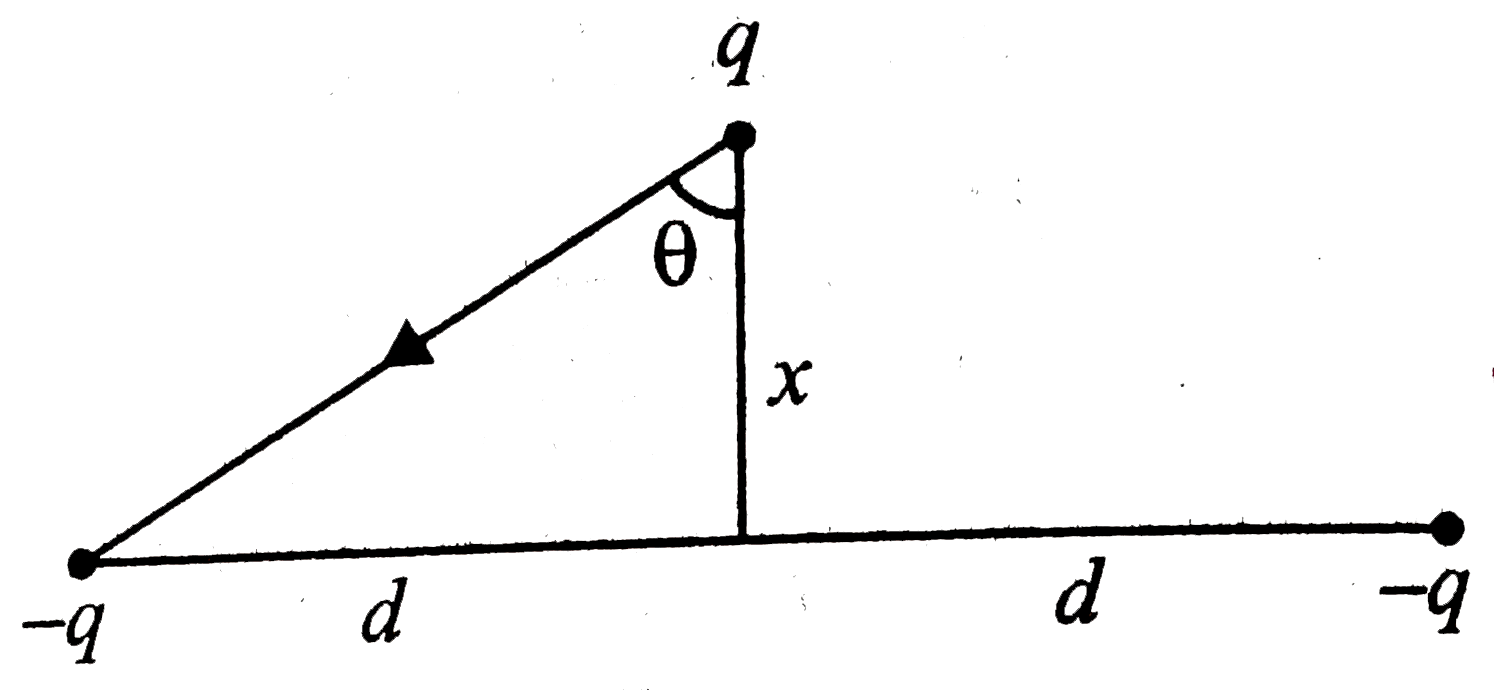Two charges q and −3q are placed fixed on x-axis separated by distance d. Where should a third charge 2q be placed such that it will not experience any force ?
d−√3d2
d+√3d2
d+3d2
d−3d2
The correct Answer is:B
To solve the problem, we need to find the position of a third charge 2q such that it experiences no net force due to the other two charges q and −3q placed on the x-axis. Here’s a step-by-step solution:
Step 1: Understand the Configuration
We have two charges:
- Charge q is located at x=0.
- Charge −3q is located at x=d.
We need to find a position x for the charge 2q such that the net force acting on it is zero.
Step 2: Determine Possible Positions
The charge 2q can be placed either:
1. Between the two charges (not feasible as explained in the video).
2. To the left of charge q (at x<0).
3. To the right of charge −3q (at x>d).
Step 3: Analyze the Forces
Let’s consider placing 2q to the left of charge q at a distance x from q. The distances from 2q to the two charges will be:
- Distance to q: x
- Distance to −3q: d+x
Step 4: Write the Force Equations
The forces acting on 2q due to the charges are:
- Force F1 due to charge q (repulsive):
F1=k⋅q⋅2qx2=2kq2x2
- Force F2 due to charge −3q (attractive):
F2=k⋅(−3q)⋅2q(d+x)2=−6kq2(d+x)2
Step 5: Set Forces Equal for Equilibrium
For the charge 2q to experience no net force, the magnitudes of F1 and F2 must be equal:
2kq2x2=6kq2(d+x)2
Step 6: Simplify the Equation
Cancelling kq2 from both sides gives:
2x2=6(d+x)2
Cross-multiplying yields:
2(d+x)2=6x2
Expanding and simplifying:
2(d2+2dx+x2)=6x2
2d2+4dx+2x2=6x2
2d2+4dx−4x2=0
Dividing through by 2:
d2+2dx−2x2=0
Step 7: Solve the Quadratic Equation
Rearranging gives:
2x2−2dx−d2=0
Using the quadratic formula x=−b±√b2−4ac2a:
Here, a=2, b=−2d, and c=−d2:
x=2d±√(−2d)2−4⋅2⋅(−d2)2⋅2
x=2d±√4d2+8d24
x=2d±√12d24
x=2d±2√3d4
x=d(1±√3)2
Step 8: Determine Valid Position
Since x must be negative (to the left of q), we take:
x=d(1−√3)2
Final Answer
The charge 2q should be placed at:
x=d(1−√3)2
We have two charges:
- Charge q is located at x=0.
- Charge −3q is located at x=d.
The charge 2q can be placed either:
1. Between the two charges (not feasible as explained in the video).
2. To the left of charge q (at x<0).
3. To the right of charge −3q (at x>d).
Let’s consider placing 2q to the left of charge q at a distance x from q. The distances from 2q to the two charges will be:
- Distance to q: x
- Distance to −3q: d+x
The forces acting on 2q due to the charges are:
- Force F1 due to charge q (repulsive):
F1=k⋅q⋅2qx2=2kq2x2
- Force F2 due to charge −3q (attractive):
F2=k⋅(−3q)⋅2q(d+x)2=−6kq2(d+x)2
For the charge 2q to experience no net force, the magnitudes of F1 and F2 must be equal:
2kq2x2=6kq2(d+x)2
Cancelling kq2 from both sides gives:
2x2=6(d+x)2
Cross-multiplying yields:
2(d+x)2=6x2
Expanding and simplifying:
2(d2+2dx+x2)=6x2
2d2+4dx+2x2=6x2
2d2+4dx−4x2=0
Dividing through by 2:
d2+2dx−2x2=0
Rearranging gives:
2x2−2dx−d2=0
Using the quadratic formula x=−b±√b2−4ac2a:
Here, a=2, b=−2d, and c=−d2:
x=2d±√(−2d)2−4⋅2⋅(−d2)2⋅2
x=2d±√4d2+8d24
x=2d±√12d24
x=2d±2√3d4
x=d(1±√3)2
Since x must be negative (to the left of q), we take:
x=d(1−√3)2
The charge 2q should be placed at:
x=d(1−√3)2
Topper's Solved these Questions
- BOOK - NCERT FINGERTPS ENGLISHCHAPTER - ELECTRIC CHARGES AND FIELDSEXERCISE - Electric Field16videos
ELECTRIC CHARGES AND FIELDS
- BOOK - NCERT FINGERTPS ENGLISHCHAPTER - ELECTRIC CHARGES AND FIELDSEXERCISE - Electric Field Lines12videos
ELECTRIC CHARGES AND FIELDS
- BOOK - NCERT FINGERTPS ENGLISHCHAPTER - ELECTRIC CHARGES AND FIELDSEXERCISE - Coulomb'S Law13videos
ELECTRIC CHARGES AND FIELDS
- BOOK - NCERT FINGERTPS ENGLISHCHAPTER - DUAL NATURE OF RADIATION AND MATTER EXERCISE - Assertion And Reason15videos
DUAL NATURE OF RADIATION AND MATTER
- BOOK - NCERT FINGERTPS ENGLISHCHAPTER - ELECTROMAGNETIC INDUCTIONEXERCISE - NCERT Exemplar6videos
ELECTROMAGNETIC INDUCTION
Similar Questions
Two charges 2μCand1μC are placed at a distance of 10cm. Where should a third charge be placed between them so that it does not experience any force.
View SolutionTwo chargea 2.0×10−6C and 1.0×10−6C are placed at a separation of 10 cm. where should a third charge be placed such that it experiences no net force due to these charges.
View SolutionTwo points charges +4q and +q are separated by distance r, where should a third point charge Q be placed that the whole system remains in equilibrium
View SolutionTwo point charges 2q and 8q are placed at a distance r apart. Where should a third charge −q be placed between them so that the electrical potential energy of the system is a minimum
View SolutionTwo fixed point charges +4e and +e units are separated by a distance a. Where should a third point charge be placed for it to be in equilibrium?
View SolutionTwo free point charges +qand+4q are placed apart a distance x. A third charge is so placed that all the three charges are in equilibrium. Then
View SolutionCharges +q and −2q are fixed at distance d apart as shown in fig.
(i) sketch roughly the pattern of electric field lines, showing the positon of neutral point.
(ii) Where should a charge partical q be placed so that it experience no force ?
 .View Solution
.View SolutionTwo point charges Q and -Q/4 are separated by a distance x.
 View Solution
View SolutionTwo charges of equal magnitude q are placed in air at a distance 2a apart and third charge −2q is placed at mid-point . The potential energy of the system is (ε0 = permittivity of free space)
View SolutionTwo charges −q each are fixed separated by distance 2d. A third charge q of mass m placed at the mid-point is displaced slightly by x(x<<d) perpendicular to the line joining the two fixed charges as shown in Fig. Show that q will perform simple harmonic oscillation of time period.
T=[8π3∈0md3q2]1/2
 View Solution
View Solution
